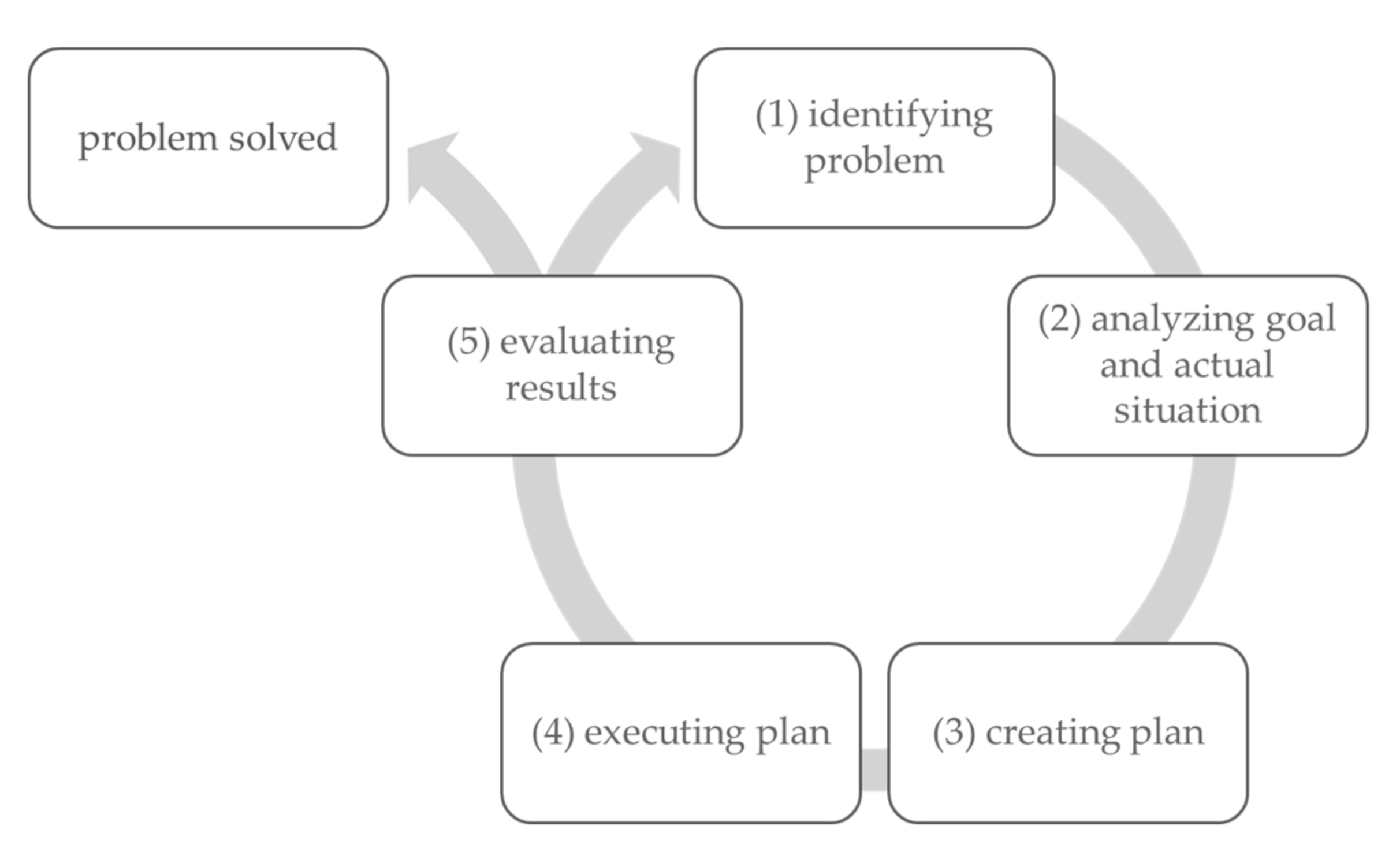Problem Solving and Digital Transformation: Acquiring Skills through Pretend Play in Kindergarten
Abstract
:1. Introduction
1.1. Problem Solving and Digital Technology
1.2. (Guided) Pretend Play to Promote Problem-Solving Skills in Digital Technology
1.3. Aims
- What kind of problems emerge during guided pretend play in the IT center?
- In what way do children solve digital problems in guided pretend play?
- What reasoning do children co-construct in guided pretend play as to the functioning of digital processes?
- How do teachers foster problem-solving skills through guided pretend play?
2. Materials and Methods
2.1. Sample and Study Design
2.2. Pretend Play Inputs
2.3. Data Collection and Analysis
3. Results
3.1. Problems That Arise during Guided Pretend Play, Where the IT Center Is Involved
A customer (child 1) calls the IT center and describes the following: “My cell phone is broken” (17:46). The IT specialist (child 2) responds and asks the customer to come over. “Hello, what’s broken?” (17:56). The customer explains that the phone is no longer working: “It doesn’t work anymore” (18:04). The IT specialist takes care of the problem and pretends to screw the phone with the screwdriver (18:14). “So, finished!” (18:18). The customer picks up his phone and leaves the IT center.
A child, pretending to be a pirate, calls the IT center and explains that the motor of the autonomous sailing pirate ship is not functioning properly (06:08). The IT specialist types on her laptop (06:18). Now she asks the pirate if the motor is working again (06:27). “No” (06:30). The IT specialist types again on her laptop and asks once again “Does it work now?” (06:36). Now, the motor is working again (06:42).
The IT specialists (children 1 and 2) are performing a technical check in the home corner: “We’re checking to make sure all the equipment is okay” (19:14). The IT specialist (child 2) notices that the refrigerator door cannot be opened and that this is probably due to the defective microchip: “But that doesn’t work... THAT doesn’t work” (19:24). The other IT specialist (child 1) reaches for the tablet and tries to scan the microchip on the refrigerator door with it. The resident (child 3) intervenes because the IT specialist has not activated the scanning app on the tablet (19:34). The IT specialists (children 1 and 2) then scan the microchip and find that it still does not work: “But it still doesn’t work” (19:45). The IT specialist (child 2) checks the SIM card and finds that the problem is caused by a defect on the SIM card: “Now we have to look at the SIM card. The SIM card is not working anymore.” (19:50). The IT specialists want to replace the SIM card (19:54). The IT specialist (1) goes and organizes a screwdriver. Following this, the IT specialist (2) screws and says, “So, now I got it” (20:45). The IT specialist (1) scans the microchip again with the tablet and checks it for functionality: “Now it works again” (21:58).
In the IT center, three IT specialists are pretending to be working, with child 1 on a tablet, child 2 at the computer, and the teacher sitting in between the children also in the role of one of the IT specialists. A customer (child 3) comes to the IT center with a laptop and says to one of the IT specialists (child 1), “The computer is broken” (04:04). The teacher, in the role of a fellow IT specialist, guides child 1 to ask the customer, “What is broken?” (04:28). The customer explains, “I don’t know either, it somehow… When you watch a movie, the movie plays in Italian” (04:32). The IT specialist (child 1) asks what language the customer needs for the videos (04:53). The customer clarifies the language “English and some more French” (05:02). The teacher involves the other IT specialist (child 2) and asks the child, “Can you please log in?” (04:58) At the same time, the IT specialist (child 1) is busy with the tablet and asks the customer, “Is this disk broken?” (05:10). The customer is shown two different disks on the tablet: “There is this one or that one” (05:14). The teacher explains to the customer that the IT specialist (child 2) will now log into the system (05:26). The IT specialist (2) logs in on the computer and starts typing. The IT specialist (1) points at his tablet and says to the other IT specialists, “Yes, that is right. It’s not the language they speak” (0:05:40). The teacher pretends to notice an error message on the computer: “Ah yes, look there’s an error message. We see it there” (05:52). She asks the IT specialist (child 2), “Can you reprogram that?” (05:57). The teacher checks with the customer that English is the desired language (06:01). The customer says, “In English and in French” (06:05). Now the teacher joins child 2 at the computer and also types and verbalizes that she is reprogramming the language: “Ok, look, the error message is gone. I think, we’ve solved the problem. However, wait a moment, I just want to have a look again, because yesterday I had…” (06:24). The teacher is typing on the keyboard of the computer again and says, “Oh, no, now the language is Chinese. Please, try to reprogram, IT specialist (child 2), you can do that” (06:34). The teacher asks the customer if it is right, that everything on his laptop is in Chinese. The customer looks at his laptop and says, “Yes.” The task of reprogramming is again given to the IT specialist (child 2) (06:39). After a new attempt (typing on the keyboard) the IT specialist (child 2) solves the problem, and the customer confirms that the correct language is now set: “It’s all good” (06:55).
3.2. How Children Solve Digital Problems
3.3. Children’s Reasoning about How Digital Processes Function
4. Discussion
5. Conclusions
Author Contributions
Funding
Institutional Review Board Statement
Informed Consent Statement
Data Availability Statement
Acknowledgments
Conflicts of Interest
References
- Shedd, A.N.; Scott, A.K.; McCullough, J.M. Careers in Engineering, Mathematics, Science, and Related Fields: A Selected Bibliography. Bulletin 1961, 8, 1–43. [Google Scholar]
- Fusaro, M.; Smith, M.C. Preschoolers’ inquisitiveness and science-relevant problem solving. ECRQ 2018, 42, 119–127. [Google Scholar] [CrossRef]
- McClure, E.R.; Guernsey, L.; Clements, D.H.; Bales, S.N.; Nichols, J.; Kendall-Taylor, N.; Levine, M.H. STEM Starts Early: Grounding Science, Technology, Engineering, and Math Education in Early Childhood; Joan Ganz Cooney Center at Sesame Workshop: New York, NY, USA, 2017. [Google Scholar]
- Ismail, N.; Ismail, K.; Aun, N.S.M. The Effect of Maternal Scaffolding on Problem Solving Skills during Early Childhood. J. Appl. Behav. Sci. 2019, 14, 76–89. [Google Scholar]
- Reuter, T.; Weber, A.; Nitz, S.; Leuchter, M. Problemlösen in digitalen Kontexten. Empirische Pädagogik 2021, 35, 5–18. [Google Scholar]
- Schallmo, D.R.A. Jetzt Digital Transformieren; Springer: Wiesbaden, Germany, 2016. [Google Scholar]
- World Economic Form Accenture. Digital Transformation Initiative. Unlocking $100 Trillion for Business and Society from Digital Transformation. 2017. Available online: http://reports.weforum.org/digital-transformation/wp-content/blogs.dir/94/mp/files/pages/files/dti-executive-summary-20180510.pdf (accessed on 4 January 2022).
- Turja, L.; Endepohls-Ulpe, M.; Chatoney, M. A conceptual framework for developing the curriculum and delivery of technology education in early childhood. Int. J. Technol. Des. Educ. 2009, 19, 353–365. [Google Scholar] [CrossRef]
- Vogt, F.; Hollenstein, L. Exploring digital transformation through pretend play in kindergarten. Br. J. Educ. Technol. 2021, 52, 2130–2144. [Google Scholar] [CrossRef]
- Van Laar, E.; Van Deursen, A.J.; Van Dijk, J.A.; De Haan, J. The relation between 21st-century skills and digital skills: A systematic literature review. Comput. Hum. Behav. 2017, 72, 577–588. [Google Scholar] [CrossRef]
- Antón-Sancho, Á.; Vergara, D.; Fernández-Arias, P. Self-Assessment of Soft Skills of University Teachers from Countries with a Low Level of Digital Competence. Electronics 2021, 10, 2532. [Google Scholar] [CrossRef]
- Priemer, B.; Eilerts, K.; Filler, A.; Pinkwart, N.; Rösken-Winter, B.; Tiemann, R.; Zu Belzen, A.U. A framework to foster problem-solving in STEM and computing education. Res. Sci. Technol. Educ. 2020, 38, 105–130. [Google Scholar] [CrossRef]
- Aschauer, W.; Haim, K.; Weber, C. A Contribution to Scientific Creativity: A Validation Study Measuring Divergent Problem Solving Ability. Creat Res. J. 2021, 1–18. [Google Scholar] [CrossRef]
- DeHaan, R.L. Teaching creativity and inventive problem solving in science. CBE Life Sci. Educ. 2009, 8, 172–181. [Google Scholar] [CrossRef] [PubMed] [Green Version]
- Betsch, T.; Funke, J.; Plessner, H. Denken—Urteilen, Entscheiden, Problemlösen; Springer: Wiesbaden, Germany, 2011. [Google Scholar]
- OECD. PISA 2012 Assessment and Analytical Framework: Mathematics, Reading, Science, Problem Solving and Financial Literacy; OECD Publishing: Paris, France, 2013. [Google Scholar]
- Funke, J. Komplexes Problemlösen—Möglichkeiten deduktivistischen Vorgehens. In Allgemeine Psychologie und Deduktivistische Methodologie; Erdfelder, E., Funke, J., Eds.; Vandenhoeck Ruprecht: Göttingen, Germany, 2004; pp. 281–300. [Google Scholar]
- DeLoache, J.S.; Miller, K.F.; Pierroutsakos, S.L. Reasoning and problem solving. In Handbook of Child Psychology: Volume 2: Cognition, Perception, and Language; John Wiley Sons Inc.: Hoboken, NJ, USA, 1998; pp. 801–850. [Google Scholar]
- NGSS Lead States. Next Generation Science Standards: For States, by State; National Academies Press: Washington, DC, USA, 2013. [Google Scholar]
- Kultusministerkonferenz (KMK). Bildung in der Digitalen Welt: Strategie der Kultusministerkonferenz; KMK: Berlin, Germany, 2016. [Google Scholar]
- Bers, M.U.; Flannery, L.; Kazakoff, E.R.; Sullivan, A. Computational thinking and tinkering: Exploration of an early childhood robotics curriculum. Comput. Educ. 2014, 72, 145–157. [Google Scholar] [CrossRef]
- Grover, S.; Pea, R. Computational thinking in K-12: A review of the state of the field. Educ. Res. 2013, 42, 38–43. [Google Scholar] [CrossRef]
- Atmatzidou, S.; Demetriadis, S. Advancing students’ computational thinking skills through educational robotics: A study on age and gender relevant differences. Rob. Auton. Syst. 2016, 75, 661–670. [Google Scholar] [CrossRef]
- Müller, C. Problem-based Learning erfolgreich gestalten. In Hochschullehre Variantenreich Gestalten. Ansätze, Methoden und Beispiele Rund um Kompetenzorientierung; Bachmann, H., Ed.; Hep: Bern, Switzerland, 2013; pp. 50–77. [Google Scholar]
- Jonassen, D.H. Toward a design theory of problem solving. Educ. Technol. Res. Dev. 2000, 48, 63–85. [Google Scholar] [CrossRef]
- McCauley, R.; Fitzgerald, S.; Lewandowski, G.; Murphy, L.; Simon, B.; Thomas, L.; Zander, C. Debugging: A review of the literature from an educational perspective. Int. Conf. Comput. Sci. Educ. 2008, 18, 67–92. [Google Scholar] [CrossRef]
- Kapur, M.; Bielaczyc, K. Designing for productive failure. J. Learn. Sci. 2012, 21, 45–83. [Google Scholar] [CrossRef]
- Kapur, M. Productive failure. Cogn. Instr. 2008, 26, 379–424. [Google Scholar] [CrossRef]
- Kjällander, S.; Mannila, L.; Åkerfeldt, A.; Heintz, F. Elementary Students’ First Approach to Computational Thinking and Programming. Sci. Educ. 2021, 11, 80. [Google Scholar] [CrossRef]
- Hirsh-Pasek, K.; Golinkoff, R.M.; Berk, L.E.; Singer, D. A Mandate for Playful Learning in Preschool: Applying the Scientific Evidence; University Press: Oxford, UK, 2009. [Google Scholar]
- Aras, S. Free play in early childhood education: A phenomenological study. Early Child Dev. Care 2016, 186, 1173–1184. [Google Scholar] [CrossRef]
- Weber, A.M.; Reuter, T.; Leuchter, M. The impact of a construction play on 5-to 6-year-old children’s reasoning about stability. Front. Psychol. 2020, 11, 1737. [Google Scholar] [CrossRef] [PubMed]
- Sundqvist, P.; Nilsson, T. Technology education in preschool: Providing opportunities for children to use artifacts and to create. Int. J. Technol. Des. Educ. 2018, 28, 29–51. [Google Scholar] [CrossRef]
- Fleer, M. Scientific Playworlds: A model of teaching science in play-based settings. Res. Sci. Educ. 2019, 49, 1257–1278. [Google Scholar] [CrossRef]
- Forman, G.E. When 2-Year-Olds and 3-Year-Olds Think Like Scientists. ECRP 2010, 12, 1–6. [Google Scholar]
- Zaldívar-Colado, A.; Alvarado-Vázquez, R.I.; Rubio-Patrón, D.E. Evaluation of Using Mathematics Educational Software for the Learning of First-Year Primary School Students. Educ. Sci. 2017, 7, 79. [Google Scholar] [CrossRef] [Green Version]
- Fridman, R.; Eden, S.; Spektor-Levy, O. Nascent Inquiry, Metacognitive, and Self-Regulation Capabilities Among Preschoolers During Scientific Exploration. Front. Psychol. 2020, 11, 1790. [Google Scholar] [CrossRef]
- Deichmann, F.; Ahnert, L. The terrible twos: How children cope with frustration and tantrums and the effect of maternal and paternal behaviors. Infancy 2021, 26, 469–493. [Google Scholar] [CrossRef]
- Eshach, H.; Fried, M.N. Should science be taught in early childhood? J. Sci. Educ. Technol. 2005, 14, 315–336. [Google Scholar] [CrossRef]
- Sakr, M. Digital Play in Early Childhood: What′s the Problem? Sage: London, UK, 2019. [Google Scholar]
- Arnott, L.; Kewalramani, S.; Gray, C.; Dardanou, M. Role-play and technologies in early childhood. In A Vygotskian Analysis of Children’s Play Behaviours: Beyond the Home Corner; Kingdone, Z., Ed.; Routledge: Milton Park, UK, 2020; pp. 76–93. [Google Scholar]
- Bird, J. “You need a phone and camera in your bag before you go out!”: Children’s play with imaginative technologies. Br. J. Educ. Technol. 2020, 51, 166–176. [Google Scholar] [CrossRef]
- Craft, A. Childhood in a digital age: Creative challenges for educational futures. LRE 2012, 10, 173–190. [Google Scholar] [CrossRef]
- Kalkusch, I.; Jaggy, A.-K.; Burkhardt Bossi, C.; Weiss, B.; Sticca, F.; Perren, S. Promoting Social Pretend Play in Preschool Age: Is Providing Roleplay Material Enough? Early Educ. Dev. 2020, 32, 1136–1152. [Google Scholar] [CrossRef]
- Perren, S.; Sticca, F.; Weiss-Hanselmann, B.; Bossi, C.B. Let us play together! Can play tutoring stimulate children’s social pretend play level? J. Early Child Res. 2019, 17, 205–219. [Google Scholar] [CrossRef]
- Weisberg, D.S.; Hirsh-Pasek, K.; Golinkoff, R.M. Guided play: Where curricular goals meet a playful pedagogy. Mind Brain Educ. 2013, 7, 104–112. [Google Scholar] [CrossRef]
- Fleer, M. Understanding the dialectical relations between everyday concepts and scientific concepts within play-based programs. Res. Sci. Educ. 2009, 39, 281–306. [Google Scholar] [CrossRef]
- Searle, K.A.; Litts, B.K.; Kafai, Y.B. Debugging open-ended designs: High school students’ perceptions of failure and success in an electronic textiles design activity. Think. Skills Creat. 2018, 30, 125–134. [Google Scholar] [CrossRef]
- Nikolopoulou, K.; Gialamas, V. ICT and play in preschool: Early childhood teachers’ beliefs and confidence. Int. J. Early Years Educ. 2015, 23, 409–425. [Google Scholar] [CrossRef]
- Bustamante, A.S.; Greenfield, D.B.; Nayfeld, I. Early childhood science and engineering: Engaging platforms for fostering domain-general learning skills. Sci. Educ. 2018, 8, 144. [Google Scholar] [CrossRef] [Green Version]
- Alberola-Mulet, I.; Iglesias-Martínez, M.J.; Lozano-Cabezas, I. Teachers’ Beliefs about the Role of Digital Educational Resources in Educational Practice: A Qualitative Study. Sci. Educ. 2021, 11, 239. [Google Scholar] [CrossRef]
- Visković, I.; Sunko, E.; Mendeš, B. Children’s Play—The Educator’s Opinion. Sci. Educ. 2019, 9, 266. [Google Scholar] [CrossRef] [Green Version]
- Kansteiner, K.; König, S. The Role(s) of Qualitative Content Analysis in Mixed Methods Research Designs. Forum Qual. Soz./Forum Qual. Soc. Res. 2020, 21, 1–22. [Google Scholar] [CrossRef]
- Bildungsdepartement Kanton St. Gallen. Kanton St. Gallen Lehrplan Volksschule—Medien und Informatik: Einleitendes Kapitel [Canton St. Gallen Elementary School Curriculum—Media and Information Technology: Introductory Chapter]; Bildungsdepartement Kanton St. Gallen: St. Gallen, Switzerland, 2017. [Google Scholar]
- Vogt, F.; Hollenstein, L.; Müller, K. Pretend Play Impulses and Videos. Available online: https://blogs.phsg.ch/weplaythefuture/pretend-play-impulses-and-videos/ (accessed on 26 January 2022).
- Kuckartz, U. Qualitative Inhaltsanalyse. Methoden, Praxis, Computerunterstützung; Beltz Juventa: Weinheim, Germany, 2019. [Google Scholar]
- Onwuegbuzie, A.; Hitchcock, J. Advanced mixed analysis approaches. In Oxford Handbook of Multimethod and Mixedmethods Research Inquiry; Hesse-Biber, S., Burke Johnson, R., Eds.; Oxford University Press: New York, NY, USA, 2015; pp. 275–295. [Google Scholar]
- Brennan, R.L.; Prediger, D.J. Coefficient kappa: Some uses, misuses, and alternatives. Educ. Psychol. Meas 1981, 41, 687–699. [Google Scholar] [CrossRef]
- Cohen, J. Statistical Power Analysis for the Behavioral Sciences, 2th ed.; Erlbaum Associates: Hillsdale, NJ, USA, 1923. [Google Scholar]
- Arnott, L. Digital Technologies and Learning in the Early Years; Sage: London, UK, 2017. [Google Scholar]
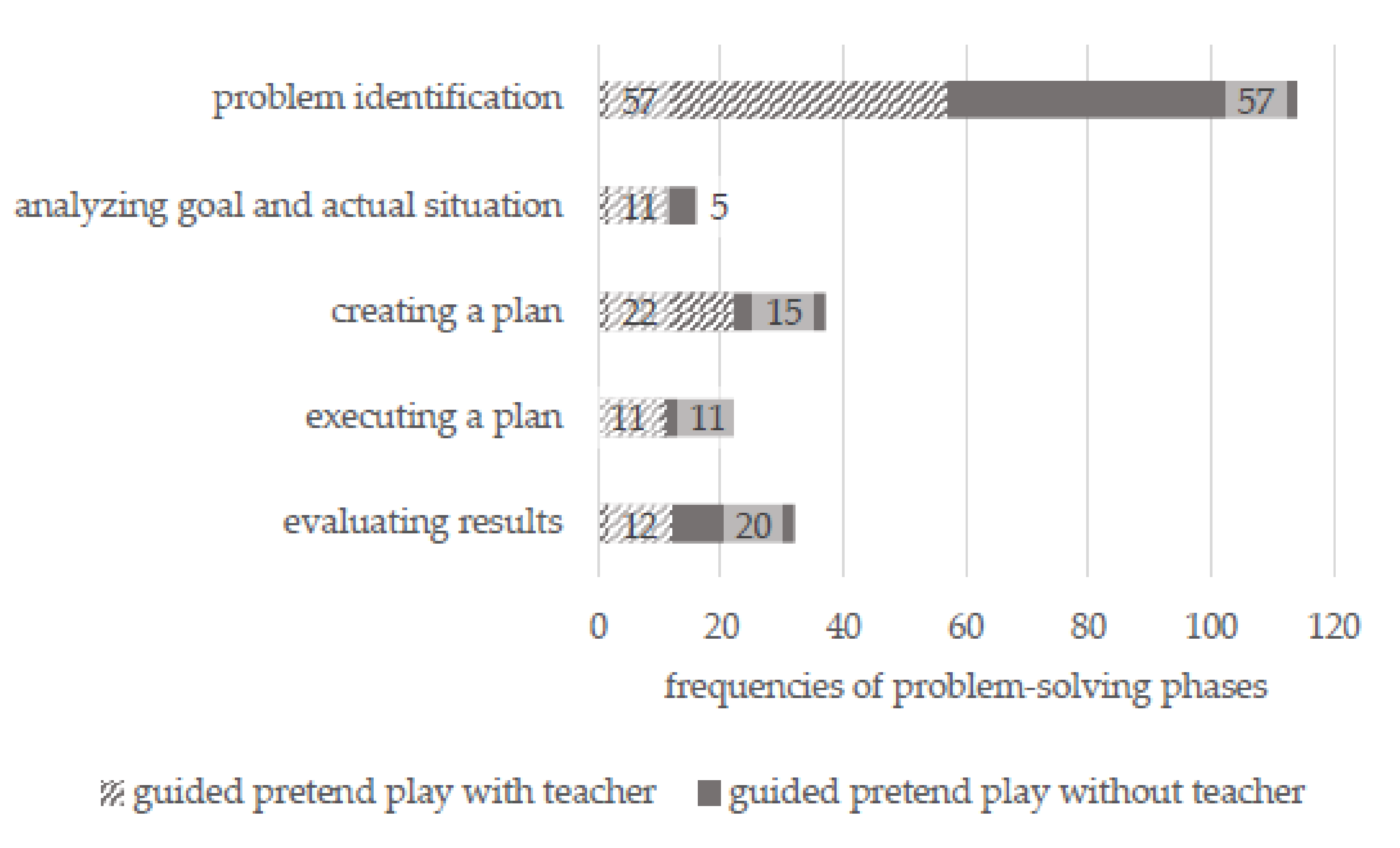

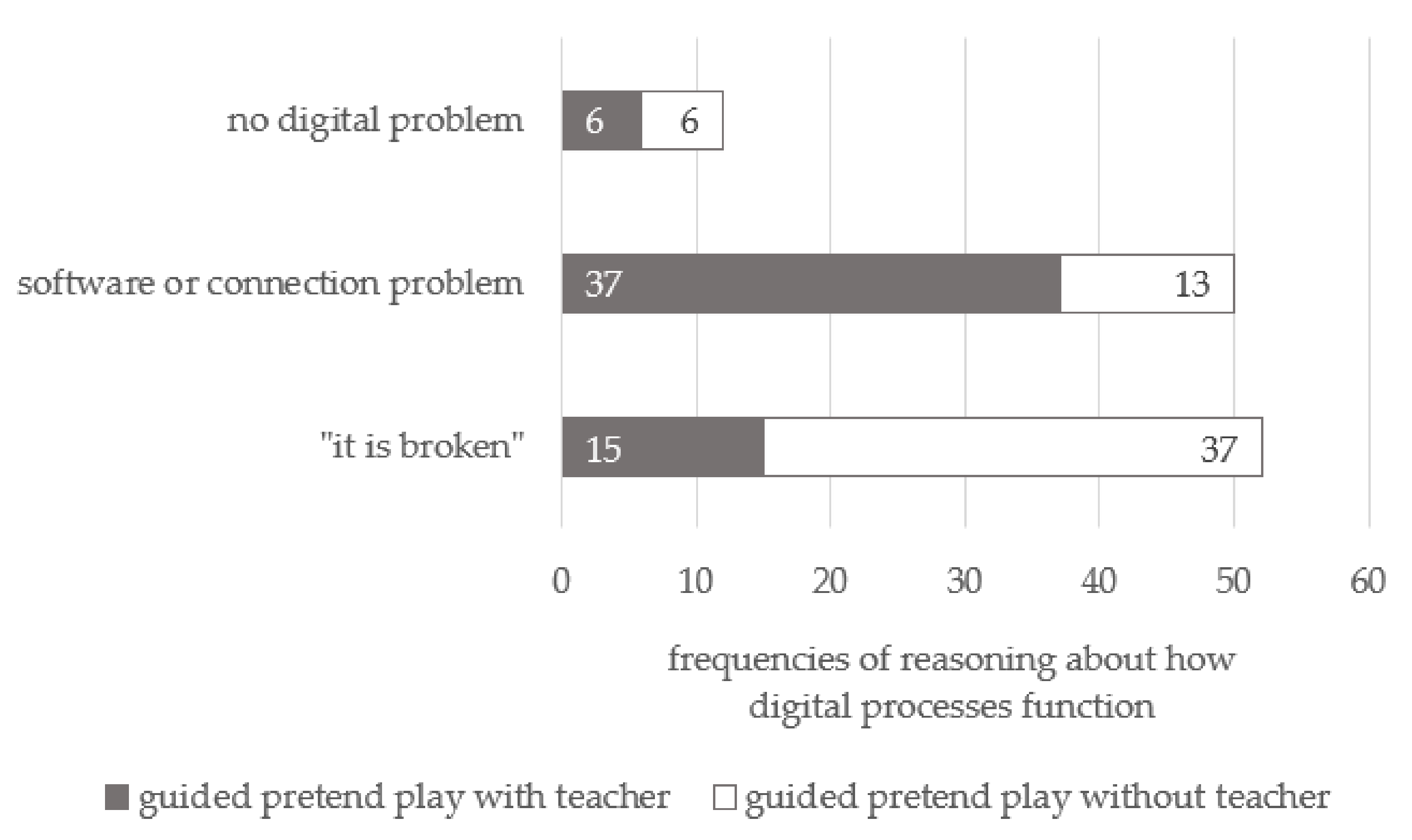
| Category | Subcategory | Reference | Example |
|---|---|---|---|
| Problem-solving situation | |||
| Teacher-guided problem-solving process | |||
| Initiating problem-solving situation | Initiated by child | ||
| Initiated by teacher | |||
| Type of problem | Design problem | [24,25] | “Can you program this for me and connect it, so I can enter the ice cream I want on the tablet from home?” |
| Diagnostic problem | “The camera is broken. It was hit by lightning.” | ||
| Debugging problem 1 | “The alarm system in the house no longer works. Can you log in and search for the problem?” | ||
| Phase of problem solving | Problem identification | [15,16] | “The refrigerator has not ordered all the desired products.” |
| Analyzing goal and actual situation | “When I watch a movie, everything is in Italian.” | ||
| Creating plan | “Wait, I still have to pack all the things I need.” | ||
| Executing plan | “There, now we remove that. No, it does not fit. Let’s take another one.” | ||
| Evaluating results | “But it still doesn’t work.” | ||
| Reasoning on how digital processes function | No digital problem | open coding | “One screw is loose.” |
| Software or connection problem | “You will have to come again, the connection does not work.” | ||
| “It is broken” | “Something is broken on the train.” | ||
| Problem-solving strategy | Modify/adapt software | open coding | “We have to reinstall this one.” |
| Typing on digital device | Typing on a digital device without verbalization of what the child/teacher is doing. | ||
| Exchange information/ask questions | “Have you disconnected the socket form the mains?” | ||
| Exchange sensor/microchips | “Maybe we need a new start button.” | ||
| Try out/test | “We need to start the refrigerator again and see if it works.” | ||
| No digital strategies | “The battery is empty; you just charge the phone.” |
| Situation | Problem-Solving Process |
|---|---|
| Children identify problems without solving the problem. | 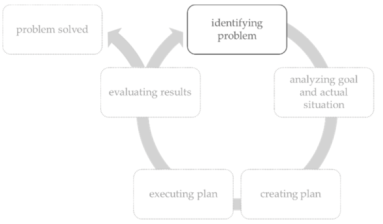 |
| Children solve the problem without verbalization of any other phase of problem solving (excerpts 1 and 2). |  |
| Children solve the problem with a minimum of one or more phases of the problem-solving process beside the problem identification (excerpt 3). | 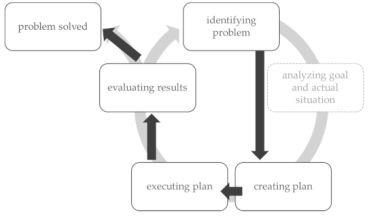 |
| Children solve the problem, with the support of the kindergarten teacher, with a minimum of one or more phases of the problem-solving process once the problem identification is complete (excerpt 4). | First cycle Second cycle 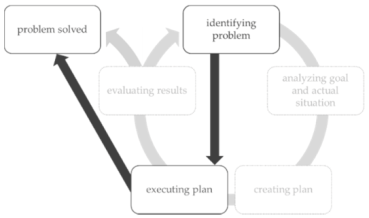 |
Publisher’s Note: MDPI stays neutral with regard to jurisdictional claims in published maps and institutional affiliations. |
© 2022 by the authors. Licensee MDPI, Basel, Switzerland. This article is an open access article distributed under the terms and conditions of the Creative Commons Attribution (CC BY) license (https://creativecommons.org/licenses/by/4.0/).
Share and Cite
Hollenstein, L.; Thurnheer, S.; Vogt, F. Problem Solving and Digital Transformation: Acquiring Skills through Pretend Play in Kindergarten. Educ. Sci. 2022, 12, 92. https://doi.org/10.3390/educsci12020092
Hollenstein L, Thurnheer S, Vogt F. Problem Solving and Digital Transformation: Acquiring Skills through Pretend Play in Kindergarten. Education Sciences. 2022; 12(2):92. https://doi.org/10.3390/educsci12020092
Chicago/Turabian StyleHollenstein, Lena, Stefanie Thurnheer, and Franziska Vogt. 2022. "Problem Solving and Digital Transformation: Acquiring Skills through Pretend Play in Kindergarten" Education Sciences 12, no. 2: 92. https://doi.org/10.3390/educsci12020092
APA StyleHollenstein, L., Thurnheer, S., & Vogt, F. (2022). Problem Solving and Digital Transformation: Acquiring Skills through Pretend Play in Kindergarten. Education Sciences, 12(2), 92. https://doi.org/10.3390/educsci12020092





